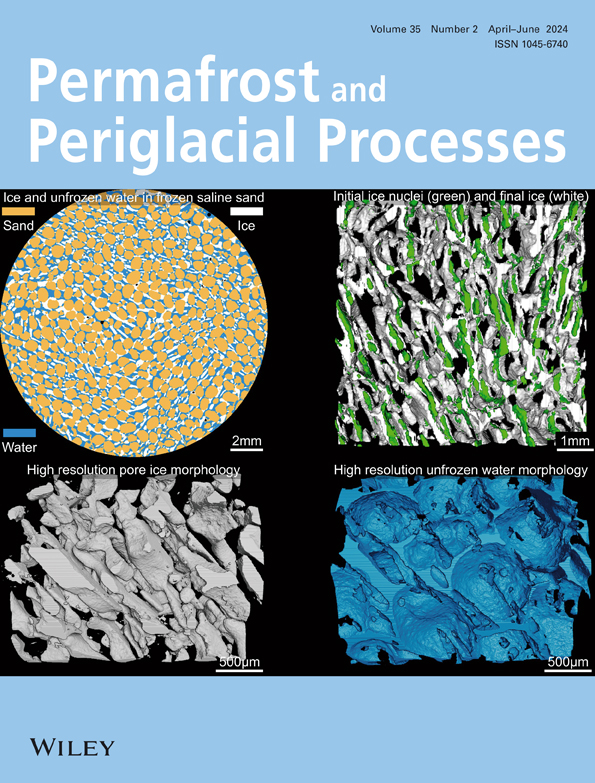A Biogeochemical Study of Greenhouse Gas Formation From Two Ice Complexes of Batagay Megaslump, East Siberia
IF 3
3区 地球科学
Q2 GEOGRAPHY, PHYSICAL
引用次数: 0
Abstract
Rapidly changing permafrost landscapes are a potential key terrestrial source of greenhouse gases (GHGs) at a global scale, yet, remain poorly characterized regarding GHG origins and environmental controls on emissions. Subsurface ice wedges, commonly found across many permafrost landscapes, harbor GHG‐rich gas bubbles. Analyzing these bubbles aids comprehension of subzero temperature GHG formation in permafrost. The Batagay megaslump, Earth's largest known thaw slump in northern Yakutia, provides an opportunity to study mixing ratios and isotopic compositions of both GHGs and non‐GHG in ice wedge samples from two stratigraphic units: the Upper Ice Complex (UIC) and the Lower Ice Complex (LIC). The Ar/N2/O2 compositions and bubble shapes indicated that the studied ice wedges were likely formed through dry snow and/or hoarfrost compaction, and microbial activity remained active after ice wedge formation. The high CO2 and CH4 mixing ratios and carbon stable isotope values suggested that CO2 and CH4 primarily originated from microbial sources. N2O showed an “exclusive relation” with CH4—meaning that high N2O is observed only when CH4 is low, and vice versa—and N2O mixing ratios vary at different depths. These findings suggest that GHG formation in ice wedges is not solely controlled by physiochemical conditions, but involves a complex interplay between microbial activity and environmental conditions. Our study contributes to a better understanding of the dynamics involved in GHG formation within degrading permafrost landscapes.东西伯利亚巴塔盖巨型塌陷区两个冰复合体温室气体形成的生物地球化学研究
瞬息万变的永久冻土地貌是全球范围内温室气体(GHGs)的潜在主要陆地来源,但在温室气体的来源和排放的环境控制方面,其特征仍然很不明显。地表下的冰楔在许多永久冻土地貌中普遍存在,蕴藏着富含温室气体的气泡。分析这些气泡有助于理解零下温度下永久冻土中温室气体的形成。位于雅库特北部的巴塔盖大坍塌是地球上已知最大的解冻坍塌,它为研究来自两个地层单元(上冰复合体(UIC)和下冰复合体(LIC))的冰楔样本中温室气体和非温室气体的混合比和同位素组成提供了机会。Ar/N2/O2成分和气泡形状表明,所研究的冰楔很可能是通过干雪和/或冰冻压实形成的,冰楔形成后微生物活动依然活跃。较高的 CO2 和 CH4 混合比以及碳稳定同位素值表明,CO2 和 CH4 主要来源于微生物。N2O 与 CH4 呈 "排他性关系"--即只有当 CH4 较低时才会观测到较高的 N2O,反之亦然--而且不同深度的 N2O 混合比各不相同。这些发现表明,冰楔中温室气体的形成并不完全受物理化学条件的控制,而是涉及微生物活动与环境条件之间复杂的相互作用。我们的研究有助于更好地理解退化永冻土地貌中温室气体形成的动态过程。
本文章由计算机程序翻译,如有差异,请以英文原文为准。
求助全文
约1分钟内获得全文
求助全文
来源期刊
CiteScore
9.70
自引率
8.00%
发文量
43
审稿时长
>12 weeks
期刊介绍:
Permafrost and Periglacial Processes is an international journal dedicated to the rapid publication of scientific and technical papers concerned with earth surface cryogenic processes, landforms and sediments present in a variety of (Sub) Arctic, Antarctic and High Mountain environments. It provides an efficient vehicle of communication amongst those with an interest in the cold, non-glacial geosciences. The focus is on (1) original research based on geomorphological, hydrological, sedimentological, geotechnical and engineering aspects of these areas and (2) original research carried out upon relict features where the objective has been to reconstruct the nature of the processes and/or palaeoenvironments which gave rise to these features, as opposed to purely stratigraphical considerations. The journal also publishes short communications, reviews, discussions and book reviews. The high scientific standard, interdisciplinary character and worldwide representation of PPP are maintained by regional editorial support and a rigorous refereeing system.

 求助内容:
求助内容: 应助结果提醒方式:
应助结果提醒方式:


